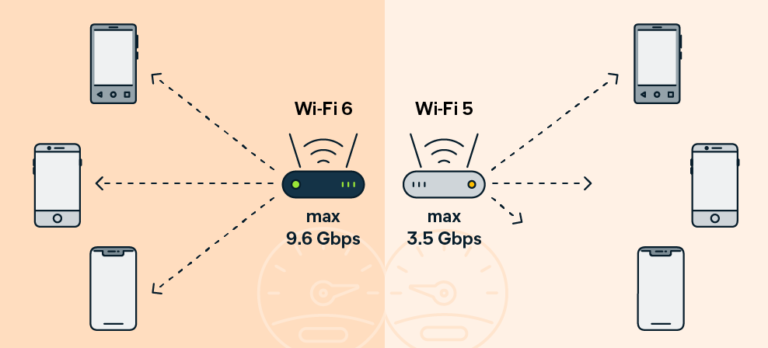The development of wireless technology is essential to meeting the constantly increasing needs for faster and more dependable internet in an era dominated by linked gadgets.
Let us introduce WiFi 6, the newest wireless communication standard that is expected to completely transform our connection experience. We’ll examine the main characteristics and advantages of WiFi 6 in this post, illuminating why it’s revolutionary for the digital era.

Table of Contents
History of Wifi
WiFi, which stands for Wireless Fidelity, is a technology that uses radio waves to allow devices to communicate data wirelessly. It replaces the need for physical wires by enabling connections between electronic devices such as computers, cellphones, tablets, and other gadgets and the internet and local area networks. Within a specific radius of a wireless access point or router, WiFi allows users to share and access data easily and adaptably by using radio frequency bands to transfer data between devices.
Wireless communication stations exchange information by transmitting and receiving discrete data blocks via radio waves, known as packets. This is accomplished through the modulation and demodulation of carrier waves, just like in all radio. DSSS on a single carrier is used by 802.11b, while multiple carriers on slightly different frequencies inside the channel (OFDM) are used by 802.11a, Wi-Fi 4, 5, and 6.
Wifi 6 Highlights
Faster Wi-Fi is on the horizon in the near future. The good news is that there is always a need for faster internet, particularly as we use our phones and computers to consume more bandwidth-intensive games, apps, and films.
However, Wi-Fi 6, the upcoming version of the network, offers more than just a speed increase. Its effects will be increasingly subtle, and as time goes on, we should start to notice more and more advantages.
Different versions of WI-FI
| Generation | IEEE standard
| Adopted | Maximum link rate (Mbit/s) | Radio frequency (GHz) |
| Wi-Fi 6E | 802.11ax | 2020 | 574–9608 | 6 |
| Wi-Fi 6 | 2019 | 2.4, 5 | ||
| Wi-Fi 5 | 802.11ac | 2014 | 433–6933 | 5 |
| Wi-Fi 4 | 802.11n | 2008 | 72–600 | 2.4, 5 |
| (Wi-Fi 3) | 802.11g | 2003 | 6–54 | 2.4 |
| (Wi-Fi 2) | 802.11a | 1999 | 5 | |
| (Wi-Fi 1) | 802.11b | 1999 | 1–11 | 2.4 |
| (Wi-Fi 0) | 802.11 | 1997 | 1–2 | 2.4 |
Wifi 6 Features
IEEE 802.11ax is an IEEE standard for wireless local-area networks (WLANs) and the replacement for Wi-Fi 5 (802.11ac). It is officially marketed by the Wi-Fi Alliance as Wi-Fi 6 (using the 2.4 GHz and 5 GHz bands) and Wi-Fi 6E (adding the 6 GHz band). Since it enhances Wi-Fi 6 customers overall in crowded areas, it is sometimes referred to as High Efficiency Wi-Fi.
Speed Redefined:
Known also as 802.11ax, WiFi 6 offers a previously unobtainable speed. Users can now experience faster downloads, lag-free online gaming, and better streaming thanks to a notable increase in data transfer rates. WiFi 6’s increased efficiency guarantees that several devices can connect at once without experiencing performance degradation.
Increased Capacity:
WiFi 6 has several notable features, one of which is its multi-device support. WiFi 6 is particularly good at handling numerous connections in congested public areas or smart homes with a high density of connected devices. In addition to improving user experience, this also helps networks remain future-proof as the number of IoT devices keeps growing.
Enhanced Range:
WiFi 6 brings improvements in range, guaranteeing a wider coverage area. Larger houses or offices where it has previously been difficult to establish a strong and continuous connection across several rooms would especially benefit from this.
Improved Performance in Crowded Areas:
In crowded areas where multiple devices compete for bandwidth, traditional WiFi networks frequently experience difficulties. WiFi 6 uses cutting-edge technology like Basic Service Set (BSS) Colouring and Orthogonal Frequency Division Multiple Access (OFDMA) to solve this problem and provide effective data delivery even in highly populated regions.
Better Security Standards:
In the digital age, security is of utmost importance, and WiFi 6 delivers. WiFi 6 comes pre-installed with WPA3, the most recent wireless security technology that offers improved encryption and defence against online threats. Users will benefit from a more secure and safe online experience as a result.
Energy Efficiency:
Better energy efficiency is a feature of WiFi 6, which helps linked devices’ batteries last longer. The ability to stay connected for longer periods of time without having to constantly look for a power source is especially helpful for users of smartphones, tablets, and Internet of Things (IoT) devices.
How much faster is Wi-fi 6?
The maximum capacity of Wi-Fi 6 over multiple channels is 9.6 Gbps. Wi-Fi 5 on the other hand provides up to 3.5 Gbps. These are theoretical maximums, though, and local networks might not be able to achieve them in operation. However, even if a Wi-Fi 6 device doesn’t use all of its available bandwidth, it might still experience noticeably quicker speeds because that maximum is shared by all of the devices.
When contrasted with Wi-Fi 5, speeds may be higher. This is presuming you have just one device connected to a Wi-Fi router. Through a number of strategies, including more effective data encoding and clever use of the electromagnetic spectrum made possible by more potent processors, Wi-Fi 6 can achieve faster data transfer speeds.
In a test configuration of a very busy home network, with security cameras running and background traffic flowing, numerous users were playing games, making video calls, and browsing the internet, Wi-Fi Alliance reported that:
- Downlink latency was reduced by up to 40%.
- Uplink latency was reduced by up to 63.
What makes Wifi -6 Faster
Orthogonal frequency-division multiple access (OFDMA), which is essentially cellular technology integrated into Wi-Fi, is the primary technology supporting 802.11ax.
Multi-user MIMO, a spatial multiplexing method, was introduced in 802.11ac (802.11’s prior modification). Utilising MU-MIMO, the access point may simultaneously send data and form beams towards each client. By doing this, it’s multiple clients may receive data at once, avoiding interference between them and increasing throughput overall.

An analogous multiplexing known as OFDMA is introduced in the frequency domain with 802.11ax. A multi-user variant of the widely used orthogonal frequency-division multiplexing (OFDM) digital modulation method is called orthogonal frequency-division multiple access (OFDMA). In OFDMA, multiple access is accomplished by allocating portions of subcarriers to certain users. This enables multiple users to transmit at low data rates at the same time.
In this way, it is possible to divide an 80 MHz channel into several Resource Units, allowing several customers to concurrently receive various kinds of data over the same frequency.
What are the requirements to Upgrade to Wifi – 6?
Make sure that all of the hardware and devices in your network infrastructure support WiFi 6 before making the switch. The following are the essential conditions:
- WiFi 6-Ready Access Point or Router:
An access point or router that supports WiFi 6 (802.11ax) is required. These gadgets have the hardware required to deliver WiFi 6’s enhanced capabilities, capacity, and speed.
- WiFi 6-Capable Devices:
Your connected devices (such as tablets, laptops, and smartphones) must also support WiFi 6 in order to take full advantage of its benefits. Modern gadgets are emerging with WiFi 6 support.
- Updated Firmware/Software:
Make that the most recent firmware or software updates are installed on your router/access point and any connected devices. Updates are frequently released by manufacturers to fix compatibility problems as well as security or performance problems.
- Consider Internet Service Provider (ISP) Compatibility:
Although WiFi 6 is primarily focused on local wireless connectivity, in order to fully take advantage of WiFi 6’s higher speed possibilities, you must have a fast internet connection from your ISP.
It is the time for an upgrade?
WiFi 6 is a major technological advancement that tackles the contemporary era’s connectivity issues. It is an appealing option for both consumers and organisations due to its speed, capacity expansion, expanded range, greater performance in crowded places, increased security, and energy economy.
WiFi 6 is a shining example of innovation in an increasingly connected society, offering a reliable and cutting-edge solution to fulfil our ever growing digital requirements. To experience a new era of wireless connectivity, upgrade to WiFi 6 right now.
Frequently Asked Questions
WiFi 6 increases the number of streams to a new high of 12 across the 2.4 and 5 GHz bands, whereas WiFi 5 has a limit of 8 in a dual band configuration.
5G operators use different frequency bands which operates between 30 GHz and 300 GHz. Wi-Fi 6 operates in unlicensed spectrum at 2.4 GHz and 5 GHz.
Wi-Fi 6E, an extension of Wi-Fi 6, operates at 6 GHz
Wifi 7 will be using 802.11be, which is expected to be available by 2024.
